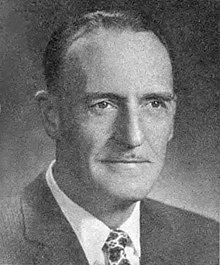This article has multiple issues. Please help improve it or discuss these issues on the talk page. (Learn how and when to remove these messages)
|
Ralph Julian Rivers (May 23, 1903 – August 13, 1976) was an American lawyer and Democratic politician who served as the first United States Representative from Alaska, serving from statehood in 1959 to his resignation in 1966 following his defeat by Republican Howard W. Pollock.[2] He previously served as the shadow U.S. Representative from Alaska Territory from 1956 to 1959.
Ralph Rivers | |
|---|---|
 | |
| Member of the U.S. House of Representatives from Alaska's at-large district | |
| In office January 3, 1959 – December 30, 1966 | |
| Preceded by | Bob Bartlett (Delegate) Himself (Shadow Representative) |
| Succeeded by | Howard Pollock |
| Shadow Member of the U.S. House of Representatives from the Alaska Territory's at-large district | |
| In office October 6, 1956 – January 3, 1959 | |
| Preceded by | Seat established |
| Succeeded by | Himself (Representative) |
| Mayor of Fairbanks | |
| In office 1952–1954 | |
| Preceded by | Robert Hoopes |
| Succeeded by | Douglas Preston |
| Attorney General of the Alaska Territory | |
| In office 1945–1949 | |
| Governor | Ernest Gruening |
| Preceded by | Henry Roden |
| Succeeded by | Gerald Williams |
| United States Attorney for the Fourth Division of Alaska Territory | |
| In office 1933–1944 | |
| President | Franklin D. Roosevelt |
| Preceded by | Julien Hurley[1] |
| Succeeded by | Harry Arend |
| Personal details | |
| Born | Ralph Julian Rivers May 23, 1903 Seattle, Washington, U.S. |
| Died | August 13, 1976 (aged 73) Chehalis, Washington, U.S. |
| Political party | Democratic |
| Education | University of Washington, Seattle (LLB) |
Biography
editBorn in Seattle, Washington to Louisa Zenaide (née Lavoy) and Julian Guy Rivers,[3] Rivers attended grammar school in Flat, Alaska, and Franklin High School in Seattle. He worked as a gold miner in Flat from 1921 to 1923, and then earned an LL.B. from the University of Washington School of Law in 1929. He then worked as a lawyer in private practice for several years.
Rivers was a lifelong civil servant, working in a number of public positions throughout his life. He served as United States Attorney for District of Alaska, from 1933 to 1944.[4] He was then elected as the attorney general of Alaska, serving from 1945 to 1949.[5] He was the chair of the Employment Security Commission of Alaska from 1950 to 1952, and then became the mayor of Fairbanks, Alaska from 1952 to 1954. In 1954 he was also president of the League of Alaskan Cities. He was a member of the Alaska Territorial Senate in 1955, and was the second vice president of the Alaska Constitutional Convention at College, Alaska in 1955 and 1956. He was a delegate to the Democratic National Conventions in 1960, 1964, and 1968.
Rivers appeared on the game show To Tell the Truth as contestant #1 in the second group of contestants on June 2, 1959.[6] Rivers died at his home in Chehalis, Washington on the morning of August 13, 1976.[7]
U.S. House of Representatives
editIn 1957 and 1958, Rivers was a United States Representative-elect under the Alaska-Tennessee Plan in Washington, D.C., on a provisional basis, pending statehood. Upon the admission of Alaska as a State into the Union, he was elected as a Democrat to the Eighty-sixth and to the three succeeding Congresses and served from January 3, 1959 until December 30, 1966.[8] He was an unsuccessful candidate for reelection to the Ninetieth Congress in 1966, resigning days before the end of his term.
Electoral history
editAlaska's at-large congressional district: Results 1958–1966[9]
| Year | Republican | Votes | Pct | Democrat | Votes | Pct | ||
|---|---|---|---|---|---|---|---|---|
| 1958 | Henry A. Benson | 20,699 | 42.5% | Ralph J. Rivers | 27,948 | 57.5% | ||
| 1960 | R. L. Rettig | 25,517 | 43.2% | Ralph J. Rivers (inc.) | 33,546 | 56.8% | ||
| 1962 | Lowell Thomas, Jr. | 26,638 | 44% | Ralph J. Rivers (inc.) | 33,953 | 56% | ||
| 1964 | Lowell Thomas, Jr. | 32,556 | 48.5% | Ralph J. Rivers (inc.) | 34,590 | 51.5% | ||
| 1966 | Howard W. Pollock | 34,040 | 51.6% | Ralph J. Rivers (inc.) | 31,867 | 48.4% |
References
edit- ^ "The Political Graveyard: U.S. District Attorneys in Alaska".
- ^ "Biographical Guide to Members of Congress". U.S. Congress. Retrieved April 21, 2017.
- ^ "Washington Birth Records, 1869-1950", FamilySearch, retrieved April 6, 2018
- ^ "District of Alaska". U.S. Department of Justice. Office of the United States Attorneys. 29 January 2015. Retrieved April 21, 2017.
- ^ "Creating Alaska-entry for Ralph Rivers". University of Alaska. Retrieved April 21, 2017.
- ^ "To Tell the Truth - Collegiate grandmother; First Alaskan in House of Representatives". YouTube. June 2, 1959. Archived from the original on 2021-12-19. Retrieved April 21, 2017.
- ^ "Obituaries - Ralph Rivers". The Daily Chronicle. August 13, 1976. p. 12. Retrieved September 5, 2024.
- ^ Warren, Kenneth F., ed. (2008). "Alaska". Encyclopedia of U.S. Campaigns, Elections, and Electoral Behavior. Thousand Oaks, CA: Sage Publications. p. 28. ISBN 978-1452265872. Retrieved April 21, 2017.
- ^ "Election Statistics". Office of the Clerk of the House of Representatives. Retrieved 2008-10-24.
- United States Congress. "Ralph Rivers (id: R000282)". Biographical Directory of the United States Congress.
External links
edit- Ralph Rivers at Find a Grave
- Ralph Rivers at 100 Years of Alaska's Legislature